2nd Trimester
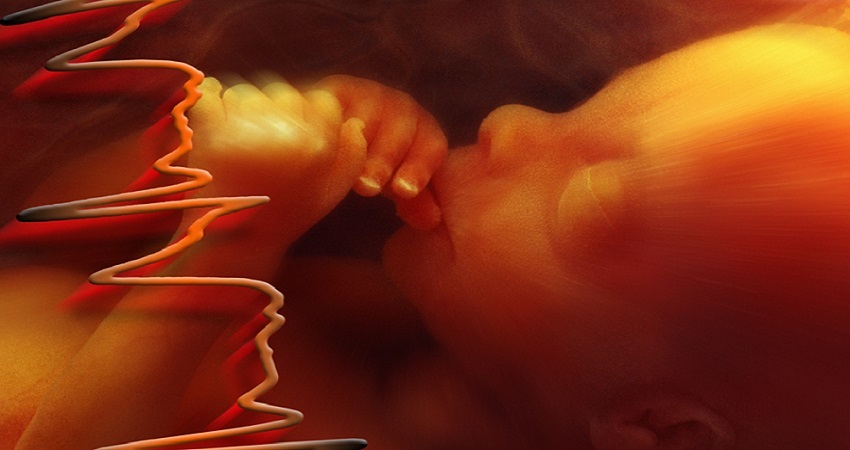
Abortions in the 2nd trimester
2nd Trimester : D&E
The D&E or Dilatation & Evacuation method was developed and largely replaced the saline and prostaglandin abortions because they were so lethal. It involves the live dismemberment of the baby and piecemeal removal from below. Used to abort unborn children as old as 24 weeks, this method is similar to the D&C.
The difference is that forceps with sharp metal jaws are used to grasp parts of the developing baby, which are then twisted and torn away A pliers-like instrument is used because the baby's bones are calcified, as is the skull.
There is no anaesthetic for the baby.
The abortionist inserts the instrument up into the uterus, seizes a leg or other part of the body, and, with a twisting motion, tears it from the baby's body.
This is repeated again and again. The spine must be snapped, and the skull crushed to remove them. The nurse's job is to reassemble the body parts to be sure that all are removed. If not carefully removed, sharp edges of the bones may cause cervical laceration. Bleeding from the procedure may be profuse.
Dr. Warren Hern, a Boulder, Colorado abortionist who has performed a number of D&E abortions, says they can be particularly troubling to a clinic staff and worries that this may have an effect on the quality of care a woman receives. Hern also finds them traumatic for doctors too, saying there is no possibility of denial of an act of destruction by the operator. It is before one's eyes.The sensation of dismemberment flow through the forceps like an electric current."
D&E abortions are dangerous, but a report from the U.S. Center for Disease Control, Dept. HEW, stated that it is still safer for the mother than the salt-poisoning or Prostaglandin method.Comparative Risks of Three Methods of Midtrimester Abortion Morbidity and Mortality Weekly Report, Center for Disease Control, HEW, Nov. 26, 1976
It is reported that every year about 100,000 women are aborted by the D&E method, between 13 and 24 weeks gestation. Of this, 500 have "serious complications." This was still judged to have a "lower risk of morbidity and mortality than the infusion procedures."MacKay et al., "Safety of Local vs General Anesthesia for Second Trimester D&E Abortions" OB-GYN, vol. 66, no. 5, Nov.1985, p. 661
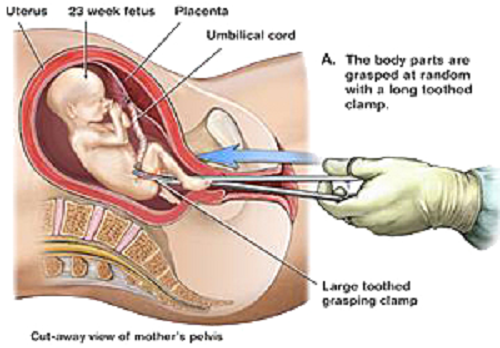
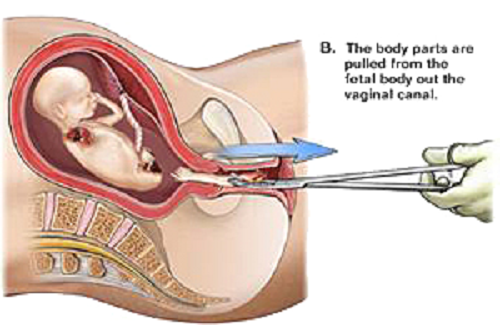
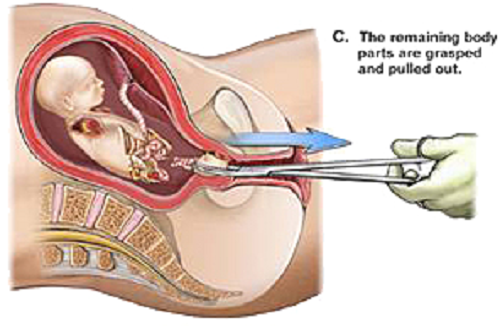
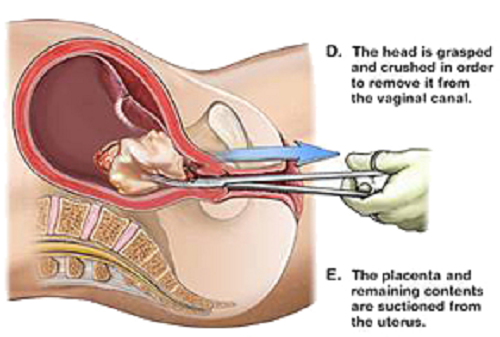
2nd Trimester : Saline
In the '70s and '80s the most common type was saline or salt poisoning abortions. These are not used much anymore because of danger to the mother. These are done after the 16th week when enough fluid has accumulated in the amniotic fluid sac surrounding the baby. A large needle is inserted through the mother's abdomen and 50-250 ml (as much as a cup) of amniotic fluid is withdrawn and replaced with a solution of concentrated salt.
The baby breathes and swallows it, is poisoned, struggles, and sometimes convulses. The chemical solution also causes painful burning and deterioration of the baby's skin. Usually, after about an hour, the child dies. When successful, the mother goes into labour about 33 to 35 hours after instillation and delivers a dead, burned, and shriveled baby. About 97% of mothers deliver their dead babies within 72 hours.
The mechanism of death is acute hypernatremia or acute salt poisoning, with development of wide-spread vasodilatation, edema, congestion, hemorrhage, shock, and death. Hypertonic saline may initiate a condition in the mother called "consumption coagulopathy" (uncontrolled blood clotting throughout the body) with severe hemorrhage as well as other serious side effects on the central nervous system.
Seizures, coma, or death may also result from saline inadvertently injected into the woman's vascular system.
Perhaps the most distressing part of a saline abortion is the sight of the expelled foetus, scalded and red from the strong salt solution. When the saline is injected into the uterus, the foetus is immersed in the salt solution. The saline gets in its eyes and nose. The foetus "breathes" the salty fluid, and swallows it. The salt solution is strong enough to eat away the tissue-thin outer layer of foetal skin.
The saline also gets from the digestive tract into the foetal blood stream, where it eats away the thin walls of the capilaries, causing them to burst. This is the reason for the mottled, bruised appearance of so many saline foetuses. The raw red skin of saline foetuses has led to abortion staff dubbing them, "candy-apple babies"
Saline abortion is hardly a pleasant experience. This is an excerpt of an account of an abortion on a saline ward from Journey Through Abortion:
Without looking up at my face, the doctor numbed a small area on my stomach and injected the saline solution directly into my womb. ... Afterwards I was wheeled back into my place ... and curtly told to wait for the "uncomfortable menstrual like cramping" to begin
My heart was pounding so loudly in my ears I thought it might explode.... Panicked thoughts whirled madly through my head. All too soon the "menstrual-like cramping" began and what little self control I had began to slip away. At 17 ... all I knew about labour was that it hurt enough to make women scream. I wanted to avoid it at all cost. That was the main reason I had chosen abortion, to avoid the pain of labour.
Ironically, all of the girls in the room and I were going through just that experience.... It hurt so bad. Tossing and turning from side to side, trying in vain to escape, I would open my eyes to see another girl a few feet away, her face twisted with pain mirroring my own.
Hours passed. The cries from everyone became louder and more intense. ... Lost in my own agony, I dimly became aware of a subtle change taking place. The nurses had begun scurrying from one patient to the next, seemingly to help them with something. Suddenly, the girl next to me began screaming for the nurses to "Get that away from me! Get it away!"
As I watched she began scrambling up to the top of her bed, trying desperately to get away from a small bloody mass lying in the middle of the bed. Abruptly, I felt a lurching sensation in my body and the nurses swiftly appeared and removed the baby I had lost and placed him in a plastic container near the head of my bed.
Wordlessly, they cleaned me up as I lay unmoving, staring at the ceiling. I didn't question anything. I did not want to know what I had done. I could not think about it at all or I would lose my mind."
The words of Nancyjo Mann from the preface to Aborted Women: Silent No More hint at the pain the foetus must experience during a saline abortion:
"For two hours I could feel her struggling inside me. But then as suddenly as it began she stopped. Even today I remember her very last kick on my left side. She had no strength left. Despite my grief and guilt I was relieved that her pain was finally over."
2nd Trimester : Prostaglandin
Prostaglandins are naturally produced chemical compounds which normally assist in the birthing process. In the '70s and '80s, prostaglandin drugs were used to induce violent premature labour and delivery. The injection of concentrations of artificial prostaglandins prematurely into the amniotic sac induces violent labor and the birth of a child usually too young to survive.
Often salt or another toxin is first injected to ensure that the baby will be delivered dead, since some babies have survived the trauma of a prostaglandin birth and been born alive. This method is used during the second trimester. When used alone a large complication rate (42.6%) is associated with its use.
Few risks in obstetrics are more certain than that which occurs to a pregnant woman undergoing abortion after the 14th week of pregnancy. In addition to risks of retained placenta, cervical trauma, infection, hemorrhage, hyperthermia, bronchoconstriction, tachycardia, more serious side effects and complications from the use of artificial prostaglandins, including cardiac arrest and rupture of the uterus, can be unpredictable and very severe. Death is not unheard of.
2nd Trimester : Urea
Because of the dangers associated with saline methods, other instillation methods such as hypersomolar urea are sometimes employed, though these are less effective and usually must be supplemented by oxytocin or a prostaglandin in order to achieve the desired result. Incomplete or failed abortion remains a problem with urea methods, often precipitating the additional risk of surgery.
As with other instillation techniques, gastrointestinal side effects such as nausea or vomiting are frequent, but the most common problem with second trimester techniques is cervical injuries, which range from small lacerations to complete detachments of the anterior or posterior cervix. Between 1% and 2% of patients using urea must be hospitalised for treatment of endometritis, an infection of the lining of the uterus.
2nd Trimester: Other Methods
Intracardiac injections. Since the advent of fertility drugs, multi-foetal pregnancies have become common. "The frequency of triplet and higher pregnancies . . . has increased 200% since the early 1970s." Since these are usually born prematurely and some have other problems, a new method has been developed.
At about 4 months a needle is inserted through the mother's abdomen, into the chest and heart of one of the foetal babies and a poison injected to kill him or her. This is "pregnancy reduction." It is done to reduce the number or to kill a handicapped baby, if such is identified. If successful, the dead baby's body is absorbed.
Sometimes, however, this method results in the loss of all of the babies.
Testimonies of 2nd Trimester Abortionists
2nd Trimester Saline Abortionist
Abortionist Dr. Szenes said...
You have to become a bit schizophrenic. In one room, you encourage the patient that the slight irregularity in the foetal heart is not important, that she is going to have a fine, healthy baby. Then, in the next room you assure another woman, on whom you just did a saline abortion, that it is a good thing that the heartbeat is already irregular.
She has nothing to worry about, she will NOT have a live baby...All of a sudden one noticed that at the time of the saline infusion there was a lot of activity in the uterus. That's not fluid currents. That's obviously the foetus being distressed by swallowing the concentrated salt solution and kicking violently and that's to all intents and purposes, the death trauma."
"One night a lady delivered and I was called to come and see her because she was 'uncontrollable.' I went into the room, and she was going to pieces; she was having a nervous breakdown, screaming and thrashing. The other patients were upset because this lady was screaming. I walked in, and here was this little saline abortion baby kicking.
It had been born alive, and was kicking and moving for a little while before it finally died of those terrible burns, because the salt solution gets into the lungs and burns the lungs too. I'll tell you one thing about D& E . You never have to worry about a baby being born alive.
2nd Trimester : D&E Abortionist
I won't describe D & E, other than to say that, as a doctor, you are sitting there tearing, and I mean tearing- you need a lot of strength to do it- arms and legs off of babies and putting them in a stack on top of the table."Dr. David Brewer of Glen Ellyn, Illinois, USA
"My official title at the mill was 'health worker.' I did various duties-lab work, leading groups (deceiving women about their abortions), "advocating" (deceiving women during their abortions), and assisting the abortionist, which included helping during the abortion and checking to make sure all the parts of the baby were there in the collection jar afterwards. I will never forget, in the second-trimester abortions, holding those little feet up to a chart on the wall to make sure of the age of the baby."Dina Madsen.
2nd Trimester : Prostaglandin Abortionist
"I was for abortion, I thought it was a woman's right to terminate a pregnancy she did not want. Now I'm not so sure. I am a student nurse nearing the end of my OB-GYN rotation at a major metropolitan hospital and teaching center. It wasn't until I saw what abortion really involves that I changed my mind.
After the first week in the abortion clinic several people in my clinical group were shaky about their previously positive feelings about abortion. This new attitude resulted from our actually seeing a Prostaglandin abortion, one similar in nature to the widely used saline abortion. . . this method is being used for terminations of pregnancies of sixteen weeks and over.
I used to find rationales. The foetus isn't real. Abdomens aren't really very swollen. It isn't 'alive.' No more excuses...I am a member of the health profession and members of my class are now ambivalent about abortion. I now know a great deal more about what is involved in the issue.
Women should perceive fully what abortion is; how destructive an act it is both for themselves and their unborn child. Whatever psychological coping mechanisms are employed during the process, the sight of a foetus in a hospital bedpan remains the final statement."
Quoted in "The Zero People: Essays on Life" by Jeff Lane Hensley, editor. Ann Arbor: Servant Books, 1983